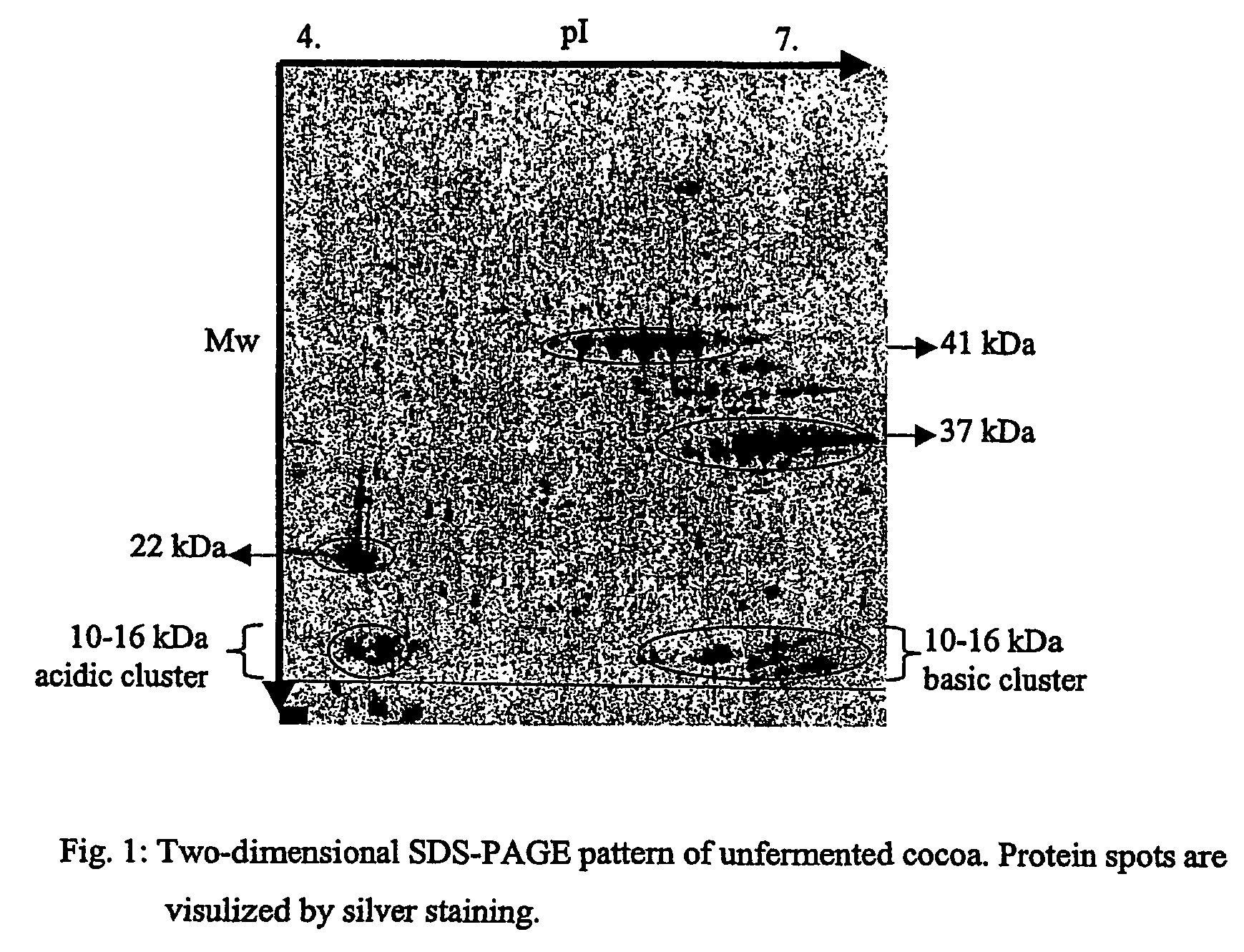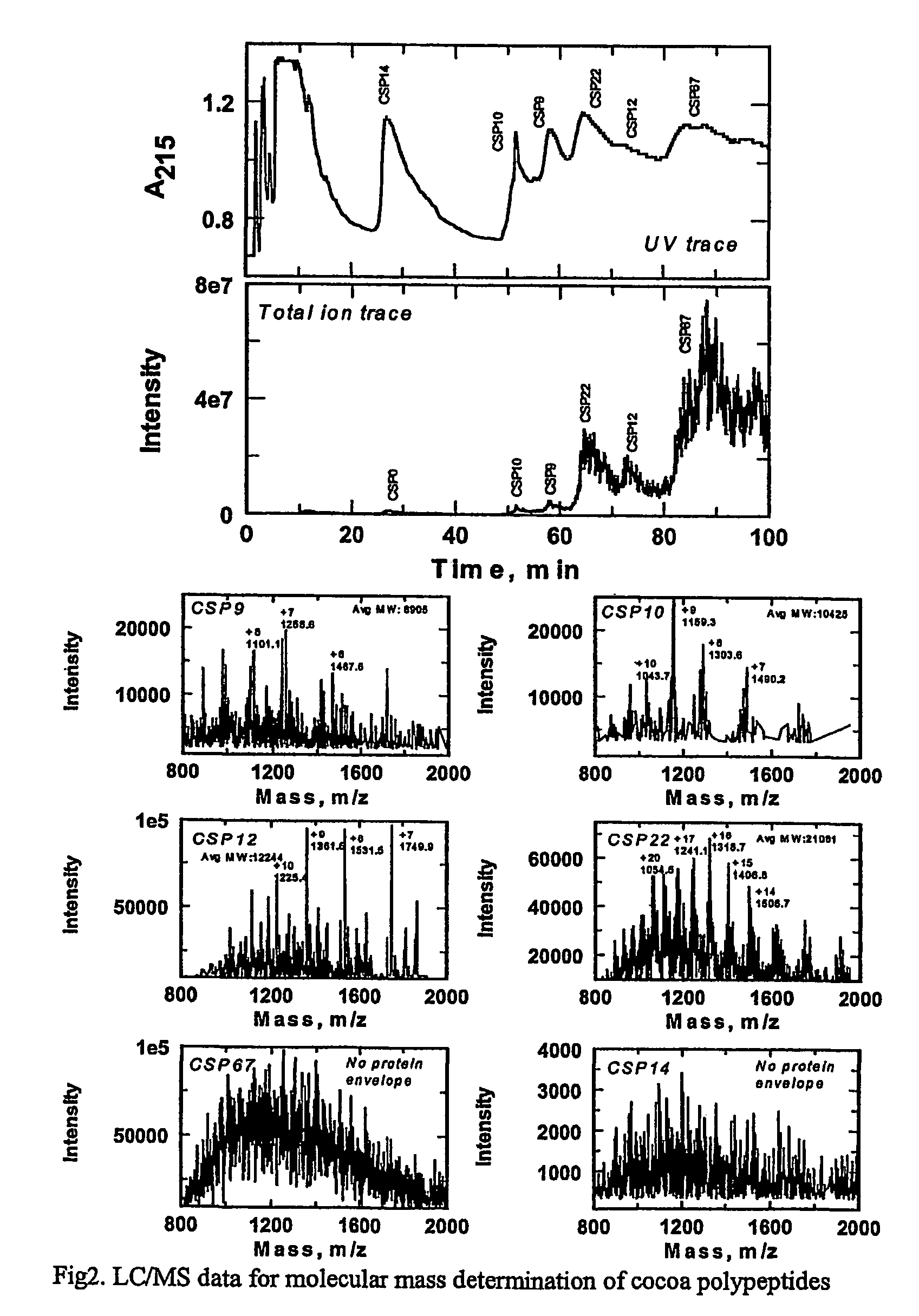Cocoa polypeptides and their use in the production of cocoa and chocolate flavor
a polypeptide and cocoa technology, applied in the field of cocoa polypeptides, can solve the problems of poor recovery of total proteins, little attention to the protein pool from which the peptide/amino acid flavor precursor pool is generated, and inability to produce the desired cocoa flavor, etc., to achieve the effect of enhancing the cocoa or chocolate flavor of a composition
- Summary
- Abstract
- Description
- Claims
- Application Information
AI Technical Summary
Benefits of technology
Problems solved by technology
Method used
Image
Examples
example 1
[0036]Separation of Proteins
[0037]Preparation of Crude Cocoa Bean Powder
[0038]Unfermented cocoa beans were obtained from Ivory Coast and unless stated otherwise all studies were carried out using West African Amelonado cocoa beans. Dried cocoa beans were passed through a bean crusher, followed by a winnover to remove shells. The nibs were kept in a brown bottle at −20° C. Cocoa nibs were milled for few seconds in an universal mill. The nib powder was passed through 0.8-mm sieve and kept at 4° C.
[0039]Two-Dimensional SDS-PAGE Electrophoretic Analysis of Unfermented Cocoa Bean
[0040]Crude (unfermented) cocoa bean powder (100 mg) was dissolved in 1 ml of solubilization buffer [8 M urea, 3% (w / v) CHAPS, 2.8% (v / v) carrier ampholytes (ampholine pH range 4–6.5, 5–8, and 3–10 (2:4:1) and 10 mM DTT (dithiothreitol)]. The clear supernatant was subjected to first dimension of separation on an immobilized pH-gradient (IPG) from 4–7, and second dimension on a 10% T SDS-PAGE gel. Proteins were vi...
example 2
[0044]Isolation of Proteins having a Molecular Weight of about 9–16 kDa
[0045]Preparation of an GndHCl Extract of CAP
[0046]Cocoa nib powder (10 g) (supra) was suspended in 200 ml 80% (v / v) aequous acetone and stirred for 1 hr at 4° C. The resulting suspension was centrifuged at 15.000 rpm for 15 min at 4° C. The residue was extracted 5-times with 200 ml 80% (v / v) aequous acetone and followed by 3-times washing with 100% acetone. The resulting acetone powder was dried under reduced pressure.
[0047]Subsequently a GndHCl extract and a pyridine-ethylated GndHCl extract of CAP from unfermented cocoa beans was prepared. 1 g CAP was suspended with 10 ml GndHCl buffer (100 mM ammonium phosphate, 66.7 mM potassium hydroxide, 3 mM EDTA and 6 M GndHCl) and sonicated for 1 min. The suspension was cooled on ice for 15–30 min and centrifuged at 15000 rpm at 4° C. for 15 min. The clear supernatant was carefully removed. In order to obtain a pyridine-ethylated GndHCl extract, the CAP extract (2 ml) w...
example 3
[0055]Characterization of Purified Proteins
[0056]The purified cocoa seed proteins CSP10 and CSP14 were subjected to N-terminal amino acid sequencing by automated Edman degradation protein sequencer. The initial and repetitive yield of Edman cycle was between 80 to 90%. The results obtained are shown in table 2 below.
[0057]
TABLE 2Initial yield,ProteinInitial amount, pmolpmolSequenceCSP10400120RREQE EESEE ETFGE FXQVX APLXP G(SEQ ID NO:3)CSP14200100GRKQY ERDPR(SEQ ID NO4)
[0058]The above listed N-terminal sequence of CSP 10 and 14 has been found to be a part of the 67 kDa vicilin type cocoa storage protein (WO 91 / 19801, supra). Thus, both of CSP 10 and 14 are so far not identified fragments of the 67 kDa vicilin type cocoa storage protein produced during the normal processing of the protein in cacao beans. By aligning the 47 and 31 kDa proteins, known to be derived from the 67 kDa vicillin protein, to the protein the remaining sequence for the CSP 10 and 14 was derived, which yielded th...
PUM
| Property | Measurement | Unit |
|---|---|---|
| molecular weight | aaaaa | aaaaa |
| molecular weight | aaaaa | aaaaa |
| molecular weight | aaaaa | aaaaa |
Abstract
Description
Claims
Application Information
 Login to View More
Login to View More - R&D
- Intellectual Property
- Life Sciences
- Materials
- Tech Scout
- Unparalleled Data Quality
- Higher Quality Content
- 60% Fewer Hallucinations
Browse by: Latest US Patents, China's latest patents, Technical Efficacy Thesaurus, Application Domain, Technology Topic, Popular Technical Reports.
© 2025 PatSnap. All rights reserved.Legal|Privacy policy|Modern Slavery Act Transparency Statement|Sitemap|About US| Contact US: help@patsnap.com


